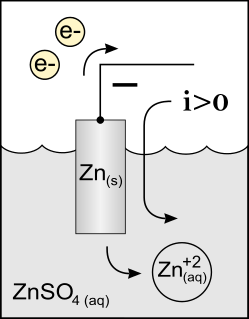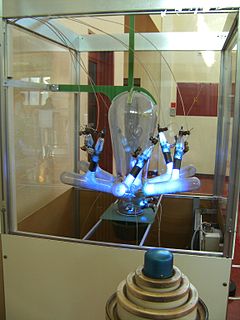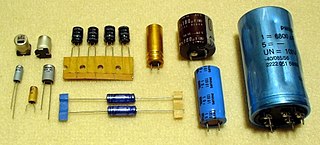Related Research Articles

An anode is an electrode through which the conventional current enters into a polarized electrical device. This contrasts with a cathode, an electrode through which conventional current leaves an electrical device. A common mnemonic is ACID, for "anode current into device". The direction of conventional current in a circuit is opposite to the direction of electron flow, so electrons flow out the anode of a galvanic cell, into an outside or external circuit connected to the cell. In both a galvanic cell and an electrolytic cell, the anode is the electrode at which the oxidation reaction occurs.

The cathode-ray tube (CRT) is a vacuum tube containing one or more electron guns, the beams of which are manipulated to display images on a phosphorescent screen. The images may represent electrical waveforms (oscilloscope), pictures, radar targets, or other phenomena. CRTs have also been used as memory devices, in which case the screen is not intended to be visible to an observer.
A cathode is the electrode from which a conventional current leaves a polarized electrical device. This definition can be recalled by using the mnemonic CCD for Cathode Current Departs. A conventional current describes the direction in which positive charges move. Electrons have a negative electrical charge, so the movement of electrons is opposite to that of the conventional current flow. Consequently, the mnemonic cathode current departs also means that electrons flow into the device's cathode from the external circuit.

A vacuum tube, an electron tube, valve or tube, is a device that controls electric current flow in a high vacuum between electrodes to which an electric potential difference has been applied.

A Nixie tube, or cold cathode display, is an electronic device used for displaying numerals or other information using glow discharge.

Corrosion is a natural process that converts a refined metal into a more chemically stable form such as oxide, hydroxide, or sulfide. It is the gradual destruction of materials by chemical and/or electrochemical reaction with their environment. Corrosion engineering is the field dedicated to controlling and preventing corrosion.

A thyristor is a solid-state semiconductor device with four layers of alternating P- and N-type materials. It acts exclusively as a bistable switch, conducting when the gate receives a current trigger, and continuing to conduct until the voltage across the device is reversed biased, or until the voltage is removed. There are two designs, differing in what triggers the conducting state. In a three-lead thyristor, a small current on its Gate lead controls the larger current of the Anode to Cathode path. In a two-lead thyristor, conduction begins when the potential difference between the Anode and Cathode themselves is sufficiently large.

Cathodic protection (CP) is a technique used to control the corrosion of a metal surface by making it the cathode of an electrochemical cell. A simple method of protection connects the metal to be protected to a more easily corroded "sacrificial metal" to act as the anode. The sacrificial metal then corrodes instead of the protected metal. For structures such as long pipelines, where passive galvanic cathodic protection is not adequate, an external DC electrical power source is used to provide sufficient current.

A silicon controlled rectifier or semiconductor controlled rectifier is a four-layer solid-state current-controlling device. The principle of four-layer p–n–p–n switching was developed by Moll, Tanenbaum, Goldey and Holonyak of Bell Laboratories in 1956. The practical demonstration of silicon controlled switching and detailed theoretical behavior of a device in agreement with the experimental results was presented by Dr Ian M. Mackintosh of Bell Laboratories in January 1958. The name "silicon controlled rectifier" is General Electric's trade name for a type of thyristor. The SCR was developed by a team of power engineers led by Gordon Hall and commercialized by Frank W. "Bill" Gutzwiller in 1957.

An X-ray tube is a vacuum tube that converts electrical input power into X-rays. The availability of this controllable source of X-rays created the field of radiography, the imaging of partly opaque objects with penetrating radiation. In contrast to other sources of ionizing radiation, X-rays are only produced as long as the X-ray tube is energized. X-ray tubes are also used in CT scanners, airport luggage scanners, X-ray crystallography, material and structure analysis, and for industrial inspection.

Electrophoretic deposition (EPD), is a term for a broad range of industrial processes which includes electrocoating, cathodic electrodeposition, anodic electrodeposition, and electrophoretic coating, or electrophoretic painting. A characteristic feature of this process is that colloidal particles suspended in a liquid medium migrate under the influence of an electric field (electrophoresis) and are deposited onto an electrode. All colloidal particles that can be used to form stable suspensions and that can carry a charge can be used in electrophoretic deposition. This includes materials such as polymers, pigments, dyes, ceramics and metals.

A mercury-arc valve or mercury-vapor rectifier or (UK) mercury-arc rectifier is a type of electrical rectifier used for converting high-voltage or high-current alternating current (AC) into direct current (DC). It is a type of cold cathode gas-filled tube, but is unusual in that the cathode, instead of being solid, is made from a pool of liquid mercury and is therefore self-restoring. As a result, mercury-arc valves were much more rugged and long-lasting, and could carry much higher currents than most other types of gas discharge tube.

"To Be, to Be, Ten Made to Be" is Tackey & Tsubasa's debut single under the Avex Trax label. This is the first retail single for their 2wenty 2wo album.
Hey! Say! JUMP is a nine-member Japanese boy band under the Japanese talent agency Johnny & Associates. The group is split into two sub-groups: Hey! Say! BEST and Hey! Say! 7. In Japan they sold more than 10 million physical copies.

The 807 is a beam tetrode vacuum tube, widely used in audio- and radio-frequency power amplifier applications.

"Missing Piece" is the debut solo single of Japanese idol Yuma Nakayama. The single includes Missing Piece as the Opening song and Mizu no kaeru basho as the insert song for his drama PIECE.

Beam deflection tubes, sometimes known as sheet beam tubes, are vacuum tubes with an electron gun, a beam intensity control grid, a screen grid, sometimes a suppressor grid, and two electrostatic deflection electrodes on opposite sides of the electron beam, that can direct the rectangular beam to either of two anodes in the same plane. They can be used as two-quadrant, single-balanced mixers or (de)modulators with very linear qualities, their mode of operation similar to one-half of a Gilbert Cell, by applying an unbalanced signal f1 to the control grid and a balanced signal f2 to the deflection electrodes, then extracting the balanced mixing products f1 − f2 and f1 + f2 from the two anodes. Similar to a pentagrid converter, the cathode and the first two grids can be made into an oscillator. Two beam deflection tubes can be combined to form a double-balanced mixer.

Aluminium capacitors are polarized electrolytic capacitors whose anode electrode (+) is made of a pure aluminum foil with an etched surface. The aluminum forms a very thin insulating layer of aluminium oxide by anodization that acts as the dielectric of the capacitor. A non-solid electrolyte covers the rough surface of the oxide layer, serving in principle as the second electrode (cathode) (-) of the capacitor. A second aluminum foil called “cathode foil” contacts the electrolyte and serves as the electrical connection to the negative terminal of the capacitor.

Assassination Classroom: Graduation is a 2016 Japanese school science fiction action comedy film directed by Eiichirō Hasumi and written by Tatsuya Kanazawa. The film is a sequel to Assassination Classroom (2015), with both films based on the manga series of the same name written and illustrated by Yūsei Matsui. It was released in Japan by Toho on March 25, 2016.
"Koro Sensations" is a single by Hey! Say! JUMP. It was released on March 15, 2015. It was released as a DVD single under the name Sensations for Ryosuke Yamada's movie, Assassination Classroom. The members each have a code name for the new unit. The group made two music videos for the single: Battle Mode and Operation Mode.
References
- ↑ "Sensations Perform 2nd Assassination Classroom Live-Action Film's Theme Song". animenewsnetwork. Retrieved September 30, 2016.